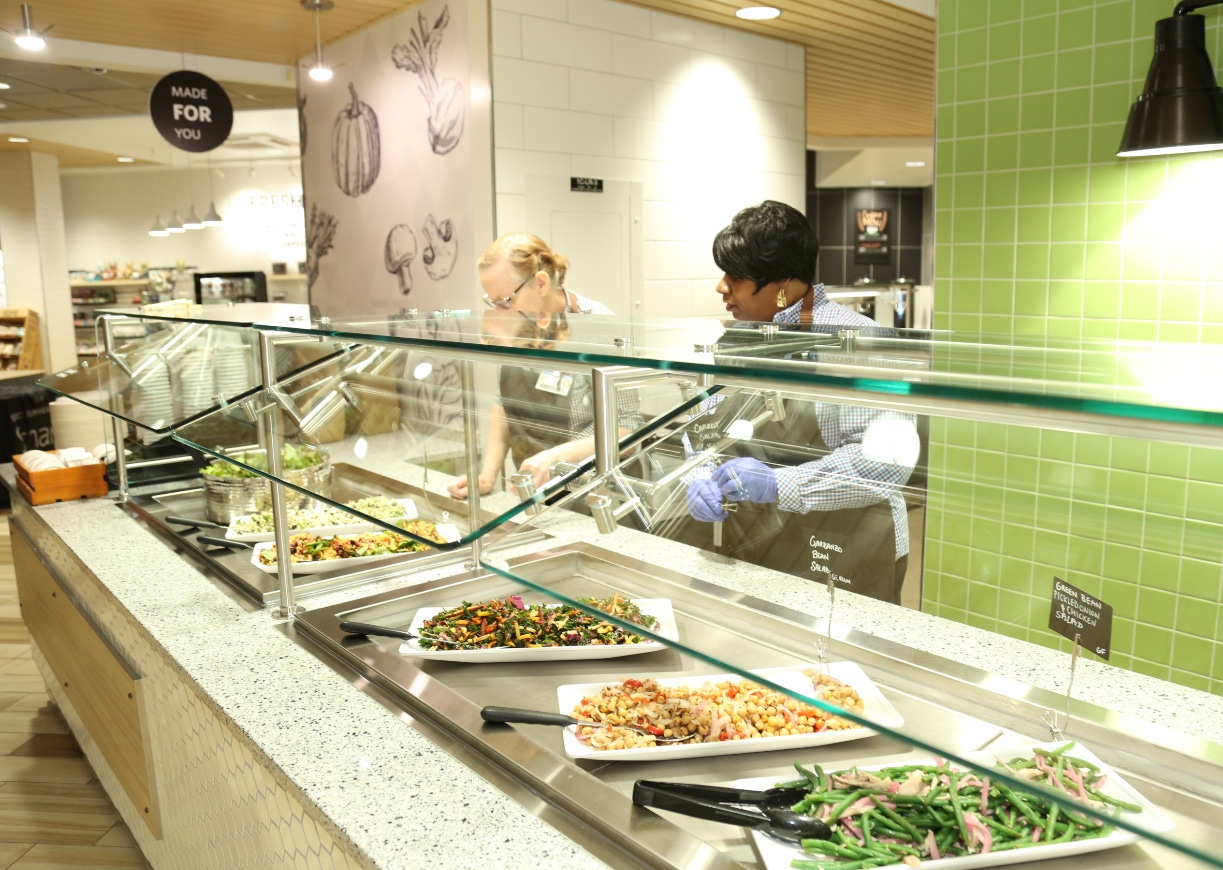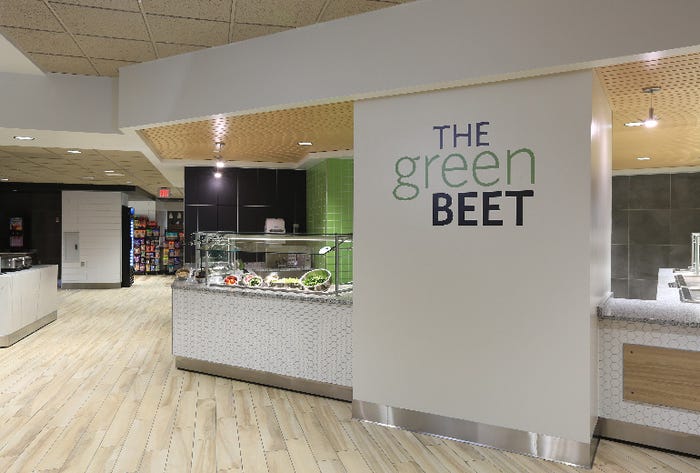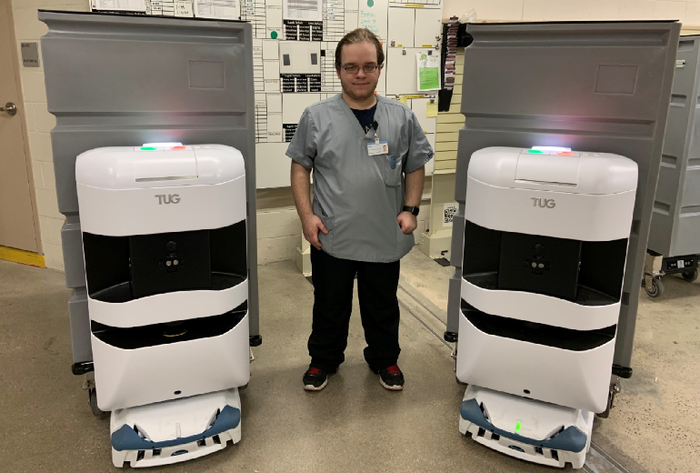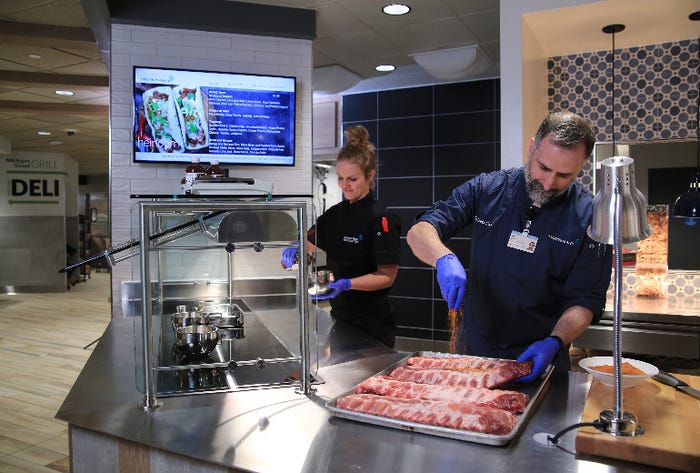Spectrum Butterworth Hospital looks to prioritize people, technology and nutritionSpectrum Butterworth Hospital looks to prioritize people, technology and nutrition
Supporting its existing staff, leveraging automation solutions to ensure continued efficient, quality customer service and emphasizing nutritious, sustainable meal options are the three priorities for Spectrum Butterworth Hospital as it comes out of the pandemic.

As with most other healthcare facilities, the COVID-19 pandemic significantly affected foodservice operations at Spectrum Butterworth Hospital in Michigan, impacting supply lines, reducing retail customer counts, limiting menu options and putting barriers between dining staff and customers. The hospital responded with modified service protocols while still maintaining a quality dining program that continued to provide its normal patient menus for the most part while adjusting retail operations to account for the reduced traffic and increased safety protocols.
Going forward, the emphasis will be on three areas, says Kevin Vos, senior director of hospitality services.
“I would expect that we are going to be back to pre-COVID volumes early in 2022, which is fantastic news,” he suggests. “I'm really focused on three things for that future. One is how do we support and develop the staff that we do have. They have been dedicated to us over the course of the pandemic and we really need to focus on them and develop them for the future. Likewise, we need to automate more and use technology more to increase our productivity, but that’s something you can't do without first supporting the staff. And then, finally, we want to put more focus on healthy nutrition for people and for the planet.”

One priority going forward for the Spectrum Health dining program is putting more focus on healthy nutrition for people and the planet.
Dedicated staff
Vos says he is especially thankful for his staff’s performance over the past year and a half, which included not only the initial impact of COVID in the spring of 2020 but significant periodic resurgences that interrupted the recovery curve, the most recent coming in late spring of 2021, when the COVID-infected patient count peaked at around 260.
“In that last surge, nursing and everyone else was getting really fatigued, and the ancillary departments I lead were really looking at ways we could assist them, because [nurses] had taken on the task of going in and out of [COVID-infected patient] rooms to deliver meals” to reduce of people getting potentially exposed.
As the initial shortages of PPE supplies eased, Vos explains, the hospital was able to transition back to having the nutrition services staff serving patient meals even to COVID-positive patients. (The staff continued to deliver food to non-COVID patients all along).
“We worked with our county health department to make sure that we were in compliance with their regulations, including training around proper PPE usage,” Vos explains. “I did have the concern when we started talking about doing this that our staff might leave in droves because they were being asked to do something that seemed unsafe.”
Fortunately, that didn’t turn out to be the case.
“As we educated and got our infection prevention team in to help us with messaging, and got the county health department involved, only a handful of people—less than five, I think—actually left the organization, and I'm talking about out of almost 400, so almost less than 1%,” Vos notes. “This was at a time when there were approximately 180 to 200 patients with COVID in our hospitals, so you think about impact to nursing, that’s almost 500 meals a day that we could take over delivery of.”
The benefit wasn’t just to nurses, but also the patents because “we could also deliver those meals quicker, so the assumption would be that the food was hotter and more enjoyable,” he adds.
Adding to the complexity for the nurses was the fact that Butterworth Hospital’s patient meal program operates a room service model that is available daily between 7 a.m. and 7 p.m., so, while it’s great for the patients, the constant flow of meals to the floors over the course of the day “stressed nursing out even more,” Vos notes.
Temporary closures of some retail locations over the pandemic period did allow Vos to allocate extra staff to keep the patient room service program going even at the height of the crisis, and the meal delivery program is also assisted by automation in the form of a fleet of 14 TUG delivery robots that haul the food from the production kitchen, one of three Spectrum hospital locations using the units for not only meal delivery but other auxiliary uses as well, such as hauling laundry. In fact, Spectrum operates the largest fleet of TUG robots in the state of Michigan, with over two dozen units total, Vos proudly notes.
“How it works is that once the trays are assembled, they are put into a cart, which is then attached to a TUG robot that transports them from the kitchen up to the units, where nutrition service technicians catch them, remove the carts and deliver the trays.”

Spectrum Health operates the largest fleet of TUG robots in Michigan, with over two dozen units in three hospital locations doing tasks such as delivering meal trays to patient floors.
Retail woes
As noted, retail operations were severely affected by the COVID-imposed restrictions and shutdowns, with the customer base diminished by bans on most visitors, restrictions on outpatient services and work-from-home mandates for administrative and other office staff reducing onsite headcounts.
Pre-COVID-19, Spectrum Butterworth had operated 16 dining outlets, including several business center offsite cafes in Grand Rapids that were shut down, along with several ancillary dining outlets on the main campus, when the pandemic hit in spring 2020. Meanwhile, many dining concepts that did remain open were adjusted in terms of operating hours and menus.
Inevitably, with almost no visitors and the business center cafes not in operation, retail sales dipped immediately and dramatically, to approximately 45% of pre-COVID-19 average weekly sales in mid-April 2020. As of mid-September of that year, the dining program at Butterworth had rebounded to 75% of the pre-COVID-19 average, though there still are some visitor restrictions and business center employees are still working primarily from home. The year ended with an overall 21% drop in overall meal sales from the previous year, a fairly respectable number given the challenges the program faced for most of the year.
One of the hospital dining outlets that remains closed is the Bistro in the Fred & Lena Meijer Heart Center, made redundant by the multi-concept Michigan Street Market that opened a couple years ago that more than doubled the size of that eatery, from around 3,000 square feet to 7,000.
“What we learned was that by adding that square feet footage, we have more capability to match the demand of our main medical center in retail meals,” Vos notes. Pre-COVID, the main medical center complex operated four smaller cafes generally themed to specialty areas such as the Helen DeVos Children’s Hospital and at the Fred & Lena Meijer Heart Center.
“Because of how food service has grown to support the medical center growth, we probably would never have shut one of those down before, but given the fact that we consolidated retail operations in the pandemic—which was one of our strategies to use our staff as efficiently as possible—we reconsidered reopening all of the [smaller cafes]. Ultimately, we chose not to reopen one [the Heart Center Bistro] while still having the capacity to meet the demand for meals.”
As for the cafes at the offsite business centers, “organizationally we have taken the stance that we will keep our employees working remotely until January 1st, 2022, so we plan to align opening those cafes with when employees come back to work,” Vos explains. “We have been able in a couple of our units to transition what were mostly manned cafes to a self-service a kind of automated point of sale,” he adds.
“Once those offsite business centers come back, I see us actually getting back to pre-COVID levels,” he suggests. “Also, we just [loosened] visitor restrictions, which is helping our volumes come back and we just gained approval from the health department and our infection prevention department to open our self-service salad bars and meal station.”
The latter is scheduled to begin sometime in July with proper mitigation strategies such as signage outlining good hand hygiene procedures and additional sanitizing, all of which nevertheless are hopeful signs that things may be on the way to turning around.

The Heirloom entrée station offers chef-created specials and rotates with the sandwich station to give overnight staff variety and quality food choices.
Serving off-hour shifts
While main cafe hours of operation stayed mostly consistent over the pandemic period, “we did limit some of the stations on second and third shift just to fit better with our labor,” Vos notes.
Second and third shift food options include an extensive grab and go selection as well as hot choices from the grill station and alternate openings of the sandwich station, where selections are made with bread from a local baker, and the Heirloom chef’s special entrée station.
“One of the things that we learned is that if we can cross-train our employees we can always have the labor to have three stations open, and we can alternate which we have open,” Vos offers. “That really is a huge advantage to our nursing employees who eat there on second and third shift in that they can get a variety of items as opposed to always just the same things.”
Notably, the grab and go section available to all shifts is a sizeable outlet, covering some 600 square feet in the Michigan Street Market and incorporating six cooler units with a broad selection of healthful items, including fresh produce and a variety of packaged creations all made in house.
“It's really what we try to showcase when people enter the market,” Vos says. “We've found that putting healthier things up front, people make healthy choices more often.”
Helping the locals
During the pandemic period, the hospital foodservice program also partnered with a couple of struggling local restaurants on providing some items to the program.
“We're constantly looking to support our local economy as we’re kind of an anchor institution the community,” Vos notes. “We gave [the partner restaurants] a certain cost that we wanted them to meet because we knew we couldn't sell $15 salads in our cafeteria, and they were then able to produce items to our specifications and the attributes that we wanted, like healthy and local. We then offered those in our main cafeteria with great success.”
That particular initiative has now ceased as commercial restaurants in the area get back on their feet with restrictions loosening, but Vos says other ways of partnering with local eateries are possible going forward, perhaps by having a local restaurant to come into Michigan Street Market and run a station for a week and offering selections from its menu.
Meanwhile, given the nationwide struggles with staffing and labor availability, Vos says he continues to explore automation solutions. All of the Spectrum system’s regional hospitals already use self-checkout technology, usually operating a manned cafeteria for breakfast and lunch but then going to self-service micro-market type operation later in the day and for second and third shift.
“We’re also exploring mobile app ordering through our dietary software vendor CBORD,” Vos adds, “and we’re looking at food manufacturing robotics as well with [a vendor] that
has a pretty nice solution for salad manufacturing” as well as units for making smoothies and premium coffee drinks. “There are so many opportunities for automation and with labor going up in cost across our country I think that there's going to be a natural evolution, something the pandemic maybe has accelerated,” he suggests.
About the Author
You May Also Like




.jpg?width=300&auto=webp&quality=80&disable=upscale)

